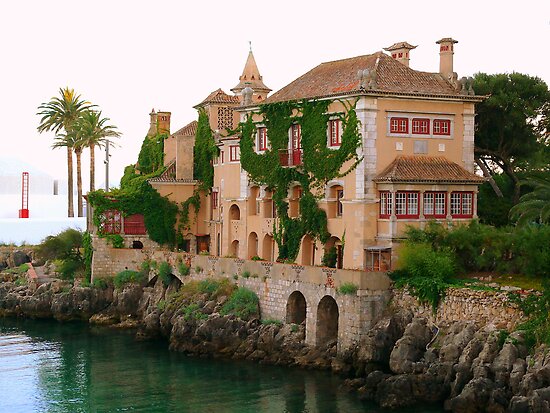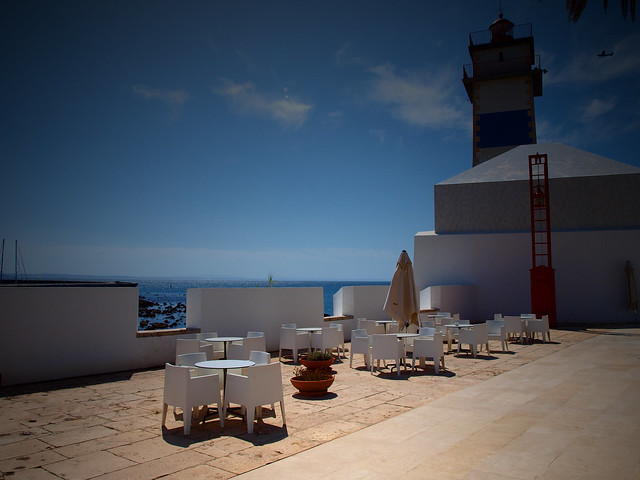 The area of Cascais - Estoril is known for its wealth of attractions, not only at the level of national heritage, but also the beauty and interest of its natural assets. This makes this area quite popular not only for foreign tourists but also by the Portuguese. Since the historic buildings dating from the fifteenth century to the present strong fortresses, churches and chapels, we can also find several parks where you can walk alone or with family in the hot summer days. Other places of interest include Boca do Inferno, a rock formation that can be found on the coast, and the marinas of Cascais and Oeiras that are more than just a place to moor yachts and boats, we can not forget the biggest casino in Europe , the Casino Estoril.
The area of Cascais - Estoril is known for its wealth of attractions, not only at the level of national heritage, but also the beauty and interest of its natural assets. This makes this area quite popular not only for foreign tourists but also by the Portuguese. Since the historic buildings dating from the fifteenth century to the present strong fortresses, churches and chapels, we can also find several parks where you can walk alone or with family in the hot summer days. Other places of interest include Boca do Inferno, a rock formation that can be found on the coast, and the marinas of Cascais and Oeiras that are more than just a place to moor yachts and boats, we can not forget the biggest casino in Europe , the Casino Estoril.Interesting Places
The area of Cascais-Estoril is rich in historical relevant sigts. From forts and palaces to stunning views there are several alternatives for many beautiful and interesting sites to see.
1 - Casa da Guia
 Casa da Guia was inaugurated in the year 1895, by D. José Saldanha Oliveira de Souza, who was the grandfather of the current owner. Situated on the cliff overlooking the Atlantic, the property includes a few restaurants and shops of clothing, accessories and jewelery.
Casa da Guia was inaugurated in the year 1895, by D. José Saldanha Oliveira de Souza, who was the grandfather of the current owner. Situated on the cliff overlooking the Atlantic, the property includes a few restaurants and shops of clothing, accessories and jewelery.
2- Câmara Municipal de Cascais

The building of Cascais Town Hall was built in the eighteenth century before the great earthquake of 1755. It is interesting to note that the date posted above the door of the House says 1821, which may mislead as to its date of construction when in reality it was the date of renewal. The facade of the House has a collection of tiles representing various Catholic saints.
3 - Fortaleza da Cidadela Cascais
Fortaleza has a new look, with new leisure facilities and Pousada de Cascais. The Citadel of Cascais reopened to the public with a new look, like restaurants and terraces, CC-Club nightclub and shops.
4 - Casa de Santa Maria
Built in 1902, Casa Santa Maria by architect José Lino, one of the most prestigious Portuguese architects of the twentieth century. This house is considered one of his most remarkable works of art.
5 - Marina de Cascais
Cascais Marina has capacity for 650 yachts with a maximum length of 35 meters. The Marina is also known for its bars and restaurants.
6 - Largo Luís de Camões
 Considered the 'center' of Cascais evening, Largo Luís de Camões is full of typical Italian food restaurants, trendy bars and Irish pubs. Another characteristic aspect of this broad is the fact that it is located quite close to the accommodation area as the House of Pergola, the Bay hotel, the Villa Albatroz, Albatroz hotel, also the Cascais train station and a taxi rank (something that can be appreciated at any given time of the night ...).
Considered the 'center' of Cascais evening, Largo Luís de Camões is full of typical Italian food restaurants, trendy bars and Irish pubs. Another characteristic aspect of this broad is the fact that it is located quite close to the accommodation area as the House of Pergola, the Bay hotel, the Villa Albatroz, Albatroz hotel, also the Cascais train station and a taxi rank (something that can be appreciated at any given time of the night ...).
7 - Rua Direita
The old Rua Direita today called Frederico Arouca street is a street parallel to the street Valbom. This street is well known for its small stands that sell accessories, beachwear and small souvenirs and handicrafts. There is also a bakery and several shops of different activities. The street got its start near the train station of Cascais and ends at Largo Luís de Camões.
8- Palácio de Seixas (Messe de Cascais)
 Built on the foundations of an ancient fort called the Fort of Santa Catarina and abandoned in the nineteenth century, was purchased to be used as a residence and renamed Ornelas Residence. Later, it was again dubbed Seixas Palace by its new owner, Henry Maufroy de Seixas, the latter bequeathed the monument to the Portuguese Navy in his last testament.
Built on the foundations of an ancient fort called the Fort of Santa Catarina and abandoned in the nineteenth century, was purchased to be used as a residence and renamed Ornelas Residence. Later, it was again dubbed Seixas Palace by its new owner, Henry Maufroy de Seixas, the latter bequeathed the monument to the Portuguese Navy in his last testament.9- Casa da Pérgola
 This charming house is in the middle of the street Valbom, parallel to the old Rua Direita in front of the famous ice cream Santini and several bookstores. The Casa da Pergola belongs to the same family for several generations who rents rooms in the house for holidays.
This charming house is in the middle of the street Valbom, parallel to the old Rua Direita in front of the famous ice cream Santini and several bookstores. The Casa da Pergola belongs to the same family for several generations who rents rooms in the house for holidays.10- Palácio dos duques de Palmela
This palace was built in the twentieth century by architect Henry Thomas. This monument is a private residence located on seawall that connects Cascais to Estoril. Although it is an emblematic building of Cascais, it has never been open to the public.
11 - Casino Estoril
The Estoril Casino is the largest casino of its kind in Europe and the oldest in Portugal. In the gardens is tradition launch Fireworks shows during festive occasions such as the celebration of the New Year.
Military Monuments
Portuguese Kings have always been concerned with the defense of the capital, Lisbon. Given the location of it, it was quickly established that the greatest military threat could only come from the sea. For this reason, they were built forts along the coast between Cabo da Roca and Belém Tower, called the 'Barra de Lisboa', to defend the maritime access to Lisbon from attacks by pirates and other enemies. Nowadays, although some are in ruins, forgotten by time, others such as the Fort of St. Julian of Barra monuments are still used by the Portuguese Armed Forces.
1- Forte do Guincho
 Forte do Guincho is located on the end of a little road, in Guincho. Access to the fort is a bit problematic, so it is advisable to have a car adapted to this purpose. Also known as the Fort of Abano due to its proximity to the beach of the same name and also as the Fort of Sails. The fort today is in ruins but a project launched by the City of Cascais will turn the monument into a center of interpretation of the Natural Park of Sintra. It was built in the seventeenth century by King John IV and is a good example of military architecture of this era.
Forte do Guincho is located on the end of a little road, in Guincho. Access to the fort is a bit problematic, so it is advisable to have a car adapted to this purpose. Also known as the Fort of Abano due to its proximity to the beach of the same name and also as the Fort of Sails. The fort today is in ruins but a project launched by the City of Cascais will turn the monument into a center of interpretation of the Natural Park of Sintra. It was built in the seventeenth century by King John IV and is a good example of military architecture of this era.2- Forte de São Jorge de Oitavos
The fort of São Jorge de Oitavos was built in 1641. Its function was to defend the Tagus river. This strong small garrisons could incorporate up to 18 soldiers with heavy artillery of 4 guns, which were removed from the fort in the nineteenth century. Opened in 2001 as a military museum by the City of Cascais, was restored in accordance with a drawing dated 1796.
3- Farol e Forte de Santa Marta
Although the main function of Farol de Santa Marta remains of the guidebook for ships and coastal signaling, the fort and lighthouse are part of a project between the city of Cascais and Marinha, which seeks to invest in the site as a center of culture and leisure, giving them the status of museum. The Lighthouse Santa Marta incorporates a museum dedicated to the history of lighthouses in much of the exposed material was donated to the museum by the Navy.
4- Forte Nossa Sra da Luz (Fortaleza da Luz)
The Fort of Nossa Senhora da Luz was initially called Torre de Santo António. Like other military buildings in this coastal area, its function was also protecting Lisbon coast. Later, due to the increasing threat of invasion by the Duke of Alba, the tower was strengthened and renamed Fort of Our Lady of Light
5- Cidadela Cascais
 The Citadel of Cascais turns out to be an extension of the Fortress of Light, and is the only part of the monument that today one can visit. Among other events of interest related to this strong, it was here that stood the 'Hospital of the Soldiers', considered the most well-equipped infirmary across the Portuguese military history. It was also in 1986 founded the first marine biology lab thanks to King Carlos. The Citadel has lost its military importance in the year 1870, hence the front was used as a summer residence by King Louis (1861-1889) and the royal family. Don't forget to visit! Nowdays it's an hotel, with shops, a nightclub, restaurants..
The Citadel of Cascais turns out to be an extension of the Fortress of Light, and is the only part of the monument that today one can visit. Among other events of interest related to this strong, it was here that stood the 'Hospital of the Soldiers', considered the most well-equipped infirmary across the Portuguese military history. It was also in 1986 founded the first marine biology lab thanks to King Carlos. The Citadel has lost its military importance in the year 1870, hence the front was used as a summer residence by King Louis (1861-1889) and the royal family. Don't forget to visit! Nowdays it's an hotel, with shops, a nightclub, restaurants..
6- Forte da Cruz
The full name of this fort is Santo António da Cruz. Although there is very little published information relating to the story of this strong in terms of their military use, we know that his defensive use became obsolete from the nineteenth century. It was around the time that the building is purchased by a 'rich capitalist' named João Martins de Barros in 1894 for his daughter who was in poor health. Since this acquisition that the fort is known as Chalet Barros.









.jpg)















.jpg)









0 comentários:
Enviar um comentário